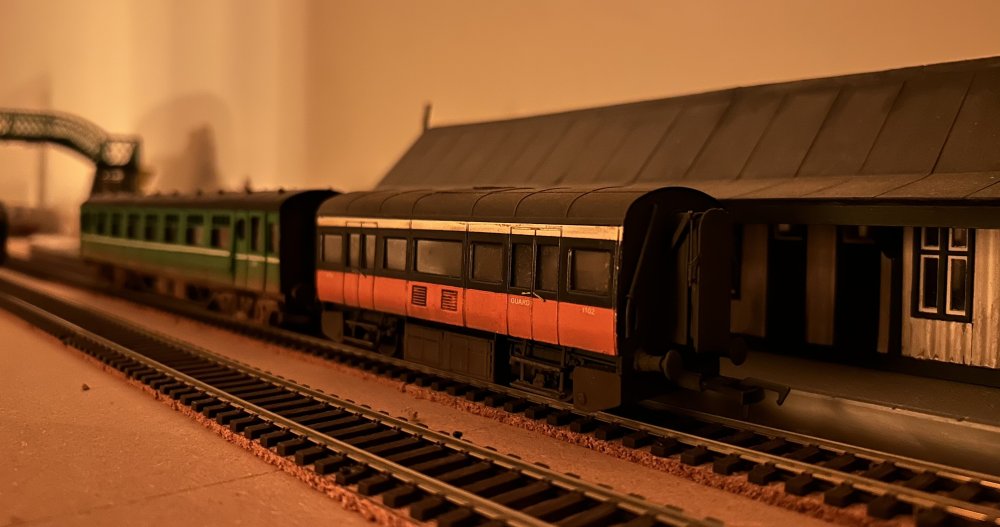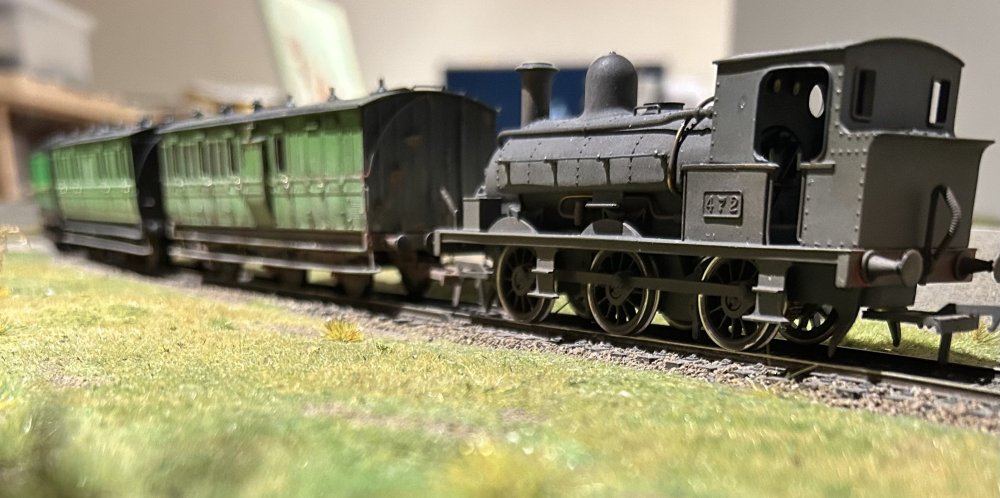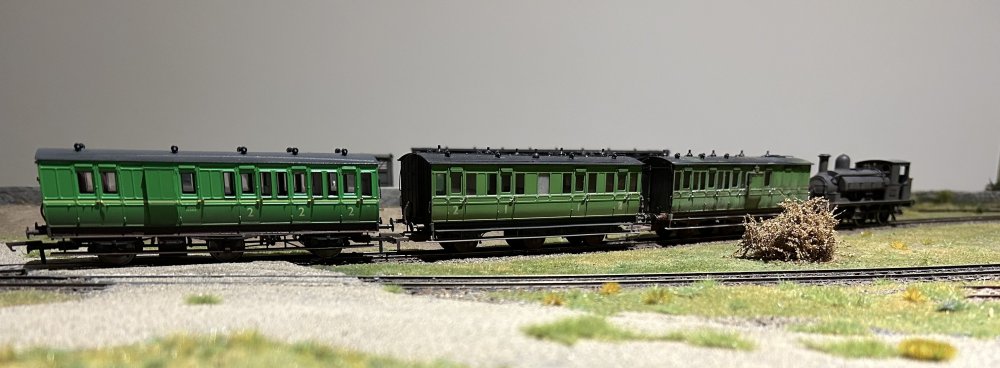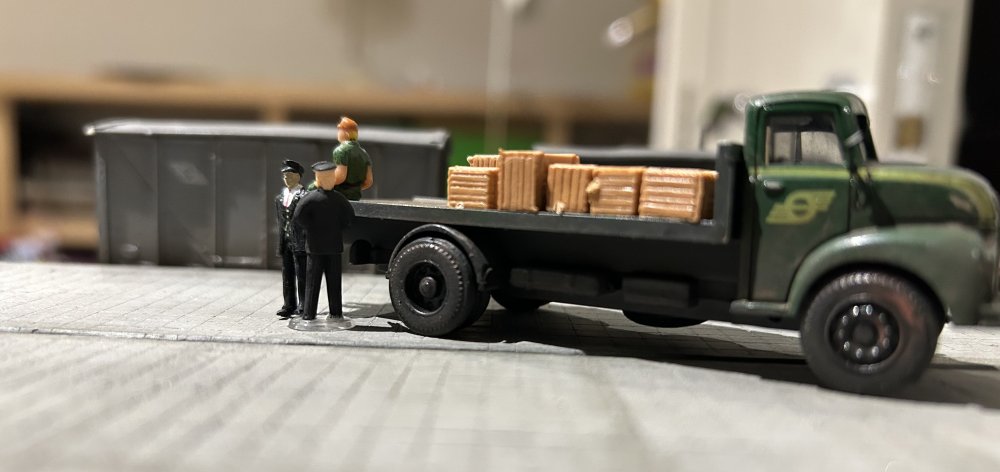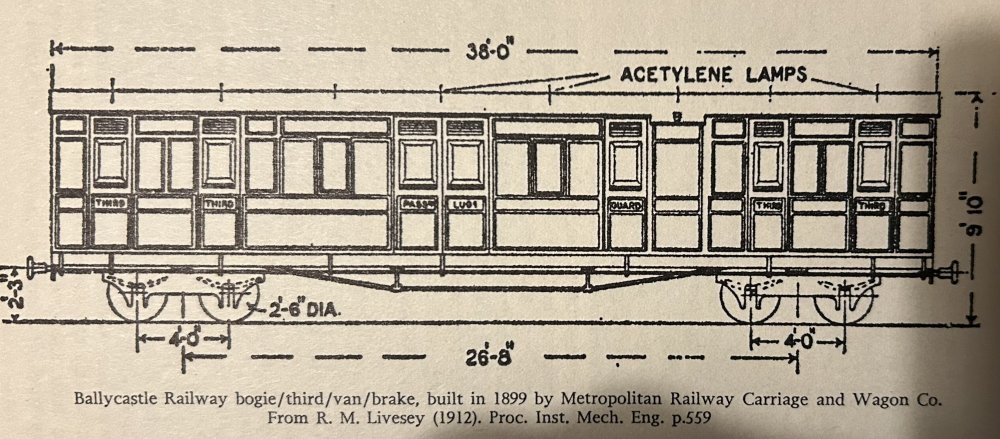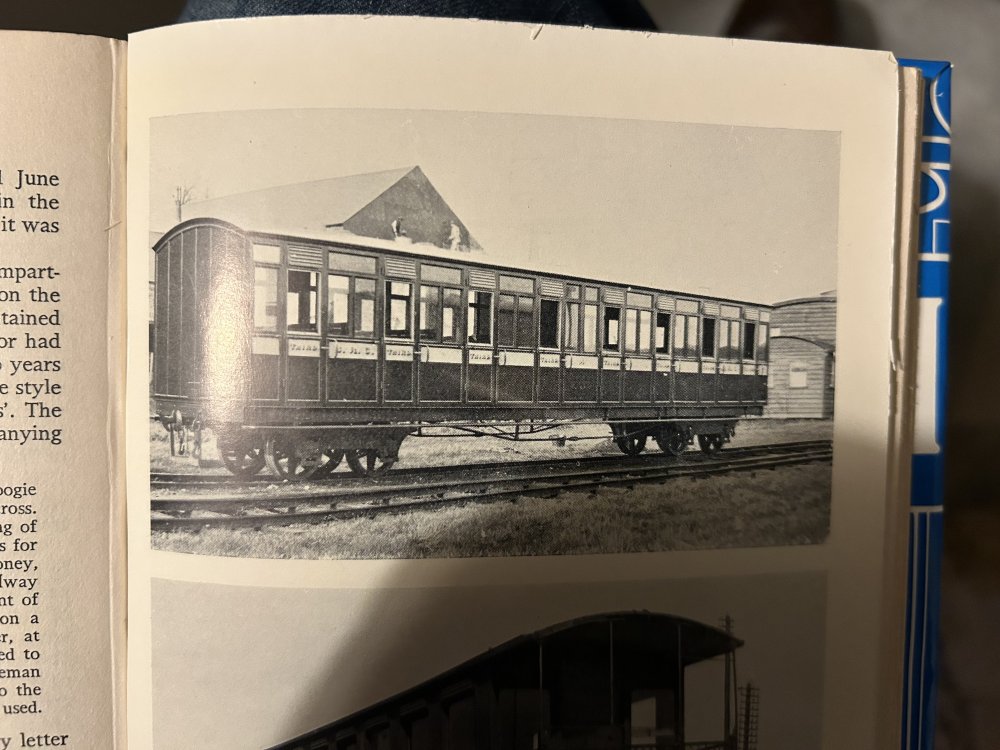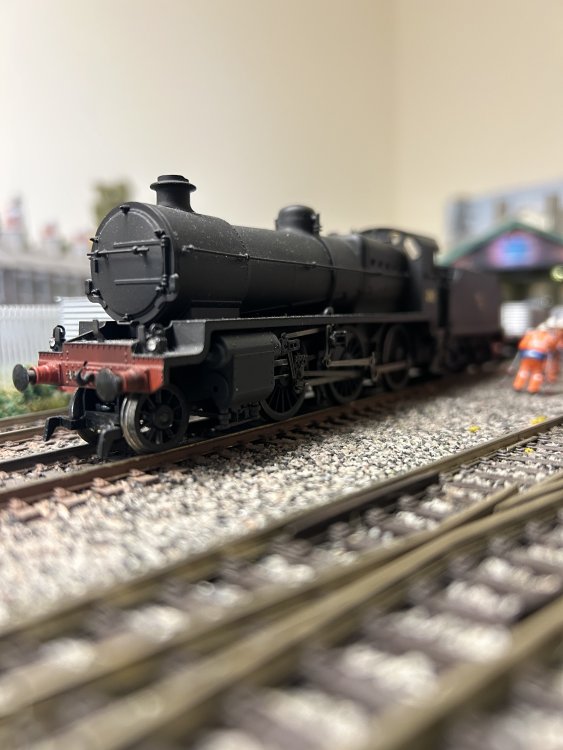-
Posts
15,866 -
Joined
-
Last visited
-
Days Won
393
Content Type
Profiles
Forums
Events
Gallery
Everything posted by jhb171achill
-
Winter sunset, Castletown West, Christmas Eve, December 1964. Stock for Tomorrow’s Christmas Day service, which CIE still had until 1965, awaits at the platform. One coach is plenty - it’s not going to be busy. As usual, a C or a B141 will provide haulage.
-
Old colour pic from 1958 showing the branch set during shunting at Dugort Harbour. The last surviving Bandon saddle tank was put out to grass at Dugort Harbour for its last fifteen years.
-
“Ye working over the Christmas?” ”Yeah, I’m on the 8.25 in the morning, then up to Margaret’s for the dinner…” ”Who’s on the afternoon train?” ”Mikey’s driving, and I think Pat’s firing….” Happy Christmas & New Year from the CIE staff and others in Castletown West and Dugort Harbour….
-
Branch line possibilities in the Black’n’tan era
jhb171achill replied to jhb171achill's topic in General Chat
Perfect candidate. Had it survived into the 1970s, you’re probably looking just 2 or 3 goods sidings for Gouldings, and a single passenger set of a 141, tin van and about three old laminates. Perfect for limited space. -
Branch line possibilities in the Black’n’tan era
jhb171achill replied to jhb171achill's topic in General Chat
Indeed - Albert Quay likewise… -
Branch line possibilities in the Black’n’tan era
jhb171achill replied to jhb171achill's topic in General Chat
The last driver, who I know (Paddy Burke) told me that about 1973/4, coach 1910 was “walloped” by a B201 during shunting. Many windows were smashed and it was deemed not worth repairing. So they replaced it with 1904! After Loughrea closed, it went back to Ballina for a short time but was soon replaced by one or (variously) two laminates and a tin van…. Interestingly, an almost carbon copy incident occurred at Loughrea in the 1930s when a loco whacked a coach while shunting… -
I heard about that. Several of the Dugort Harbour PW gang attended, with a few bottles of holy water from yer man out beyond No. 2 gates…..
-
First, horse boxes. While it was common, if not traditional in some lines, to have these in passenger livery, they were grey or unlined maroon in GSR days. When maroon, ends were too. Initially in CIE days they were plain unlined (dark) green, ends included, but with small painted flying snails as on wagons (in pale green, obviously) rather than the snail transfers put on loco tenders, buses and carriages. After 1955/6/7, any repainted got the plain lighter green. From 1962, any repaints were standard wagon grey. The green “H” vans - according to official reports over 100 were supposed to be green - but as others mentioned the livery changed after months, so in actual fact very few indeed actually entered traffic that way. An unconfirmed report I had years ago suggested that 4-6 were painted that way, but no more. Personally, I suspect that somewhat more were, but by no means many; and (as others have observed) what few did get the green, didn’t keep it long. Within my own observation of these wagons, all over Ireland, and dating back to the early 1960s, I never saw a single green H. And I saw goods trains on an almost daily basis from 1962 onwards. My perception (unconfirmed), from those long deceased who would have “known stuff”, was that initially at any rate, they were intended for Cork - Tralee mails, and to be hauled by the ICRs of the day - the AEC railcars, which were almost the staple on those services. I’ve yet to see a picture, though, of one behind an AEC, let alone on that route, but I’m aware they did do that.
-
It’s a ten-millionth of a cubit!
-
-
-
Indeed. I'm aware, too, that SeniorX2, while Chief Draughtsman, made several official visits to Derby with his engineering colleagues….
-
-
What’s interesting too, is that despite the passenger livery applied - green sides but the rest black, roofs appear to have been grey. Standard passenger livery for coaching stock had black roofs on all types of stock in all liveries, until the first Mk 2s in 1972.
-
Correct - I had forgotten about that one! And it probably had the least legroom between seats of any carriage in Ireland! Pretty much! I’m not sure if the West Clare ever had red - I’d need to check, but what I am aware of is that the GSR used used the very dark brownish-maroon “crimson lake” to repaint them all after 1925.
-
The Ballycastle Rly Co was GWR-style brown and cream - original BR stock which I think was all six-wheeled. After takeover it was standard Midland Railway (England) - later unlined LMS maroon of similar shade, on the ex-B&L stock brought in for the reopening. After the UTA took over, they repainted several locos but none of the carriages ever got UTA green, as the line was closed 18 months later. Aim for 1925/6 and you’d have a mixture, as not everything was repainted at once!
-
Branch line possibilities in the Black’n’tan era
jhb171achill replied to jhb171achill's topic in General Chat
Exactly. An excellent example. Fenit, Castleisland and Youghal all had heavy, albeit only occasional, excursion traffic. Had West Cork survived, probably the same to Clonakilty. 141 class heaven….. -
Two acquaintances of mine (neither on here to my knowledge) are planning / slowly putting together smallish layouts based on fictitious branches on the CIE system in the 1960-75 period. Both had asked me what’s likely to have been on it, knowing that on a British equivalent a Beeching survivor would probably have a staple diet of single-car or 2-coach railcars (DMUs over there), with the terminus is done cases being a single set of points. But railcars (AEC sets) in Ireland were the stuff of main lines and Dublin suburban, not branch lines, the few of which survived having remained entirely loco-hauled until the early 2000s. While Beeching was learning his spellings, rural closures were well under way here, and between 1959 and 1963, all but a few of our branches breathed their last, often (Foynes, Kenmare etc) with six wheel coaches and steam engines which actually bore-dated the line itself. But, what if there were still trains in the 1960s or early 70s to Killeshsndra? Or Mountmellick, Ballinrobe, Shillelagh, Banagher, Valentia, Clonakilty, Kinsale, Ballaghaderren or Achill? ”Ah”, I hear you say, “just model it on Loughrea”. Well, yes and no. The fact that Loughrea retained cattle and mixed trains into the 1970s doesn’t mean other lines would have done. Cattle volumes across CIE in 1968 were but a tenth of the equivalent a decade earlier; when even that was only half what the late 1930s would have produced. Also, there were only 7 of the G611 class, and at least two of these spent much of their time at Inchicore, despite being only a few years old. Even with 20 functioning branches, it’s hard to see Gs going anywhere else. Even at Loughrea, as I’ve found through recent research, more often than not a C or a B141 was allocated, even a B181 or A class, before and after re-engining. And therein lies the answer. An Irish 1960s branch will have an almost staple diet of 141s and Cs. If there’s a functioning turntable still, a 121 could appear. Wagons would obviously be standard types, mostly standard CIE “H” and plans, and ex-GNR vans too; with a mix of Bullied corrugated opens and older timber-buried ones, the latter of either GSR, CIE or GNR origin. Coaches - a set of one or two laminates, Park Royals or Bredins. Cravens would be rare and usually limited to visiting specials or excursions. So, at entry level, a layout like that can be convincingly put together with a Murphy 142, a pair of IRM Park Royals, a SSM or other tin van*, half a dozen IRM Bullieds (no, I’m not on commission) several Provincial timber-bodied vans, a Provincial or SSM guards van, and maybe a dozen GNR or CIE goods vans of Provincial or IRM origin. (The “Provincial IRM”?….!!!!) (* Any post-steam or pre-ICR middle passenger train MUST have a guards van & generator vehicle. Sticking two Cravens behind a loco and nothing else is like operating a passenger train without a locomotive! Pity there isn’t a credible RTR Genny van, but it’s needed!)…. I have a long term interest in the Achill line. Had that survived, you’d have been looking at two passenger trains a day, and a goods…. and 141s.
-
If it’s of any help, livery details for CBPR carriages were - mud grey roofs, black chassis, dark green sides, probably with yellow lining but lining colour not reliably documented anywhere I’m aware of. Ends almost certainly green too. From looking at pigments, I believe the green was probably something like what British Railways had onnsteam engines in the 1950s. Locos were black, with red lining. On takeover by the GSR, the four locos were painted grey pretty quickly, and the carriages painted in full GSR maroon livery. Even many of the station signs were quickly replaced by standard GSR bilingual enamels. On the subject of GSR coach B livery, while the standard was black coach ends, I’ve found quite a few instances of the dnds being maroon as well, often on narrow gauge types. With several Passage coaches having observation ends, I wouldn’t be surprised if all stock on that line was like that.
-
The Eagle Has Landed - NIR Hunslets Next For Accurascale IRM
jhb171achill replied to Warbonnet's topic in News
The NIR publicity pic at the container yard looks very futuristic! -
Now you’re making me drool. SLNCR “B” roaring and labouring its way round the mountainside above Bellacragher Bay, or on the long climb from the Owengarve river bridge up to Mulrany!
-
The big issue, of course, would have been what would have happened when the British companies were nationalised. It might have brought nationalisation here (1950) ahead by two years.
-
Interesting concept. Had the NCC and MGWR been physwically connected, you'd have had one owned by the (English) Midland Railway, and the other by the LNWR, up to 1923, but they would have had become one system after that. This, in turn, would have limited the GSR to little more than the GSR and the narrow gauge lines, and possibly resulted in the subsuming of the CDR into the LMS. But the GNR was in the middle between the, and was itself at one stage contemplating amalgamating with the DSER. Given all that, any supposition as to what might have happened has far too many variables to be anything other than pure fantasy, but certainly an interesting one. The Fishguard company became in operational terms part of the GSR, so a British owned Irish company wholly within the Irish Free State might also have been operated like that. As an aside, it's equally interesting to wonder whyat way our railways would have developed had Ireland never been divided into two separate political jurisdictions....
-
CIE locomotive livery variations 1960-1990
jhb171achill replied to jhb171achill's question in Questions & Answers
Absolutely superb and invaluable piece of work, Mol! -
100% agree
.png.c363cdf5c3fb7955cd92a55eb6dbbae0.png)

